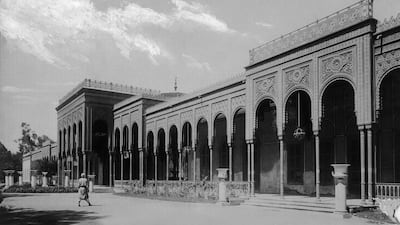The Gezirah Palace is a dominating presence on the island of Zamalek in Cairo.
Built in 1869 for the inauguration of the Suez Canal, it stands proud as a link to Egypt’s historical importance in the world. Commissioned by the Khedive Ismail, or viceroy Ismail, the palace was designed by the Austrian architect Julius Franz and fashioned in the image of the Palace of Versaille to impress France’s Empress Eugenie, the wife of Napoleon III.
Speculation is still rife over the Khedive’s love for the empress, but whether he was enamoured and if his love was reciprocated remains unknown. Still, Egypt’s rather wanting Taj Mahal is now the Cairo Marriott Hotel with the original palace dwarfed by two lofty towers that house more than 1,000 rooms.
It is a comfortable hotel for business travel, well located in the centre of Cairo but shaded from the hustle and bustle of the city.
While tourism in Egypt faced a huge decline following the 25 January 2011 revolution, business tourism from the GCC in particular has enjoyed a steady rise over the past couple of years. The Marriott has thus invested in the property, refurbishing the swimming pool and the gym in recent months.
The rooms at the Marriott (starting from US$160 per night) are spacious enough, with a large king-sized bed, a glass-topped desk and access to both European and UK plug outlets. Rooms are equipped with iron and ironing board and a comfortable sofa and futon for when working at the desk becomes too tiresome.
Bathrooms have Acca Pacca-brand amenities but something is usually missing, be it slippers, a bathrobe or a shaving kit. Having to call guest services is a tedious and time-wasting exercise for guests. Saying that, each request is met with exceptionally warm Egyptian hospitality while room service is quick with a menu that includes tasty traditional local dishes like fuul, taamiya and lentil soup.
Wi-Fi is available throughout the property, but it can be problematic. The Marriott’s Wi-Fi policy seems to be rather intrusive and I found my emails and various other applications on my phone refused to work due to an "insecure network". For a business traveller this is worrying and the only solution is to purchase a local sim or use a private Wi-Fi hotspot.
____________
Read more:
Dukes Dubai: a classy British-themed hotel on Palm Jumeirah
London’s Shangri-La at the Shard is top notch
____________
The business centre is small, but contains the basic facilities to get through work including a photocopier, printer and several computers. There is also a small meeting room available for hire, seating six, but those staying in the executive suites ($395 per night) can make full use of the meeting rooms in the executive lounge free of charge.
The Marriott boasts some of the more opulent conference halls in Cairo, including the Aida ballroom and the palace balcony, which overlooks the gardens, an impressive backdrop for meetings and conferences.
For those after more casual meeting spots in the Marriott, there are 12 dining options and the six-acre garden and promenade offers al fresco dining from the traditional Egyptian restaurant Somaa Basha to Italian at the Ristorante Tuscany. Fine dining at the impressive Saraya Gallery with its antique ceiling is a step back into Cairo’s opulent past.
The hotel’s historic significance is felt throughout the property, thanks to the watchful eye of the ministry of antiquities. The lobby houses the world’s first clock with Arabic numerals, along with some of the original furniture while the royal staircase is a truly splendid sight leading down to the promenade.
But like the now defunct lions fountain in the garden, on my stay I felt the Gezirah Palace had lost its charm. Despite the recent renovations, there’s a sense of fatigue to the property. The rooms are out-dated, the lobby is always teeming with people and check out time can be exceptionally long if you’re not a Marriott member. What must have been the height of luxury in all of Cairo has now lost some of its glitter.

